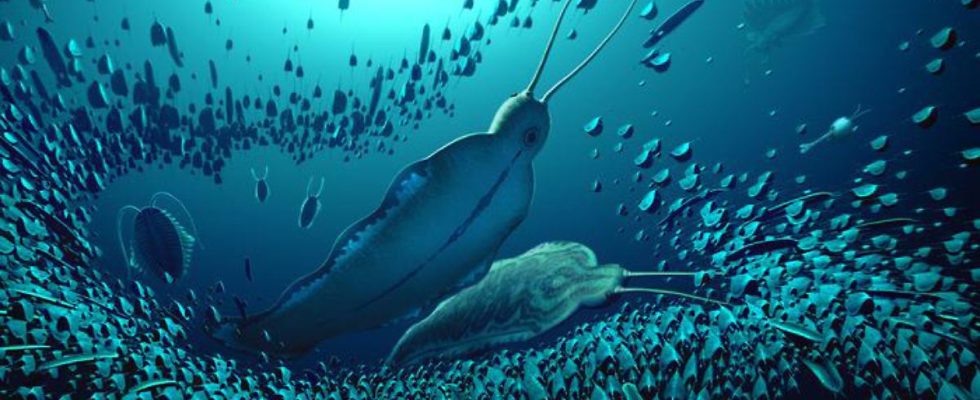First predator of evolution
Dreadworm ruled the ancient seas
January 8, 2024, 5:30 a.m
Listen to article
This audio version was artificially generated. More info | Send feedback
The 500 million year old predatory worm has the horror in its name: Timorbestia koprii plowed through the seas and ate small arthropods. Researchers now found the remains in the monster’s stomach.
More than 500 million years ago, a giant worm swam through the ancient seas and ate other animals. This is what a research team concludes from fossil discoveries in northern Greenland. The worm, called Timorebestia koprii, was up to 20 centimeters long without antennae. With antennas it reached up to about 30 centimeters, as the group reports in the journal “Science Advances.” According to researchers, it was one of the first predators.
The Latin genus name Timorebestia means something like “fearsome beast”. Because of their size, the ancient worms were probably high up in the food chain. “This means they were just as important in the Cambrian as some of the largest predators in modern oceans, such as sharks and seals,” said Jakob Vinther from the University of Bristol (UK), who led the team along with Tae-Yoon Park from the Korea Polar Research Institute in Incheon (South Korea). The Cambrian is the oldest age of the ancient world and stretched from around 540 to around 490 million years ago.
“We already knew that primitive arthropods were the dominant predators in the Cambrian,” reports Vinther. But before trilobites and other arthropods became the rulers of the seas, there were apparently worms, because in the stomachs of some of the 13 fossil specimens of Timorebestia koprii the researchers found remains of extinct arthropods of the genus Isoxys. The fossils come from the Sirius-Passet faunal community found in northern Greenland, containing mostly Cambrian molluscs deposited in seafloor mud.
Even nervous system examined
Using modern electron beam microanalysis with a resolution of up to a thousandth of a millimeter, Vinther and Park’s team were able to visualize many of the mollusc’s structures. “Thanks to the remarkable, exceptional preservation in Sirius Passet, we can also reveal exciting anatomical details, including their digestive system, muscular anatomy and nervous system,” Park said.
Very unusual is a large nerve knot (ganglion) in the abdominal area, as can also be found in today’s arrowworms (Chaetognatha). According to researchers, it was most likely an ancestor of modern arrowworms, which are smaller today and also live in the sea. Jaw structures of T. koprii indicate a relationship with the pine mouths (Gnathostomulida), modern marine worms that grow up to four millimeters long. “We have many more exciting findings to report in the coming years that will help reveal what the earliest animal ecosystems looked like and developed,” says Park.
The so-called Cambrian Explosion gave rise to many new animal phyla, many of which still exist today. In August, researchers presented the earliest known clear representative of a free-swimming jellyfish. The species Burgessomedusa phasmiformis lived 505 million years ago. The prehistoric shrimp Anomalocaris, which has been known for a long time, also lived more than 500 million years ago. According to researchers, it was even one meter long and is said to have had particularly good compound eyes.

